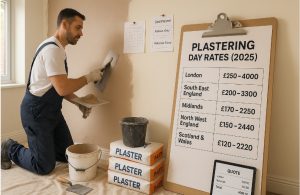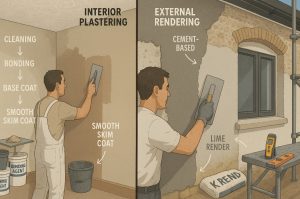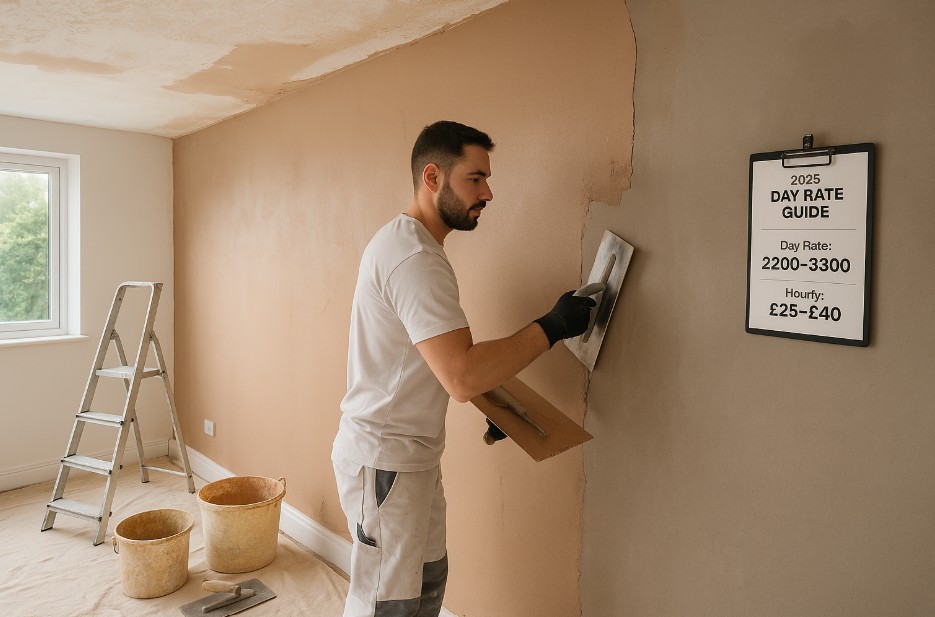Plastering Day Rate: What You Should Expect to Pay in 2025?
Plastering, skimming, and rendering are among the most effective ways to rejuvenate the interior and exterior of a property. These tasks not only enhance aesthetics but also increase the market value of a home.
A classic example is skimming old Artex ceilings a popular renovation project known to boost appeal in property listings. In 2025, the demand for quality plastering services in the UK remains high, and so do the expectations around cost.
For homeowners, landlords, or developers planning renovations, understanding how plastering day rates are calculated is essential.
With significant cost variations across regions and job types, having a clear overview of what you should expect to pay can save you both time and money.
This guide explores the average plastering day and hourly rates, the types of work involved, and the key considerations when hiring a professional plasterer.
What Is the Average Plastering Day Rate in the UK?

The cost of hiring a plasterer in the UK is most commonly expressed as a day rate, particularly for full-room projects.
In 2025, the average plastering day rate ranges from £150 to £250, although in high-demand urban areas like London, this can rise to £300 or more.
At the lower end of the scale, in rural areas of Wales and Scotland, the day rate may fall to around £120.
Most plasterers will complete one room per day, so the day rate effectively provides a benchmark for calculating project costs.
It’s important to remember that day rates typically cover labour only, unless otherwise stated. Material costs such as plaster, bonding agents, and tools are usually quoted separately.
Here is a general breakdown by region:
| Region | Day Rate Range (£) |
| London | 250–400 |
| South East England | 200–300 |
| Midlands | 170–250 |
| North West England | 150–240 |
| Scotland & Wales | 120–220 |
While the day rate provides a helpful estimate, plasterers often prefer to quote based on the scope of the job, particularly the size and condition of the room or wall being worked on.
What Is the Average Hourly Rate for a Plasterer?
For smaller, straightforward jobs such as patch repairs, ceiling touch-ups, or damage caused by leaks plasterers may charge by the hour. In 2025, the average plasterer cost per hour in the UK is £25, with typical ranges falling between £15 and £50.
Hourly rates are usually applied when:
- The job duration is less than a full day.
- The task involves minimal setup and cleanup.
- Access is easy and materials are limited.
However, most plasterers still prefer quoting per job or day, especially when the task could exceed a few hours or involve more extensive labour.
What Factors Influence Plastering Rates in the UK?

Plastering costs vary based on multiple criteria, and understanding these variables can help you budget more accurately and negotiate fair pricing.
1. Type of Plastering Work
Different plastering tasks command different prices due to their complexity and required materials. For example:
- Skimming is usually the cheapest and quickest. It involves applying a thin layer of plaster to smooth existing surfaces.
- Full plastering includes base coats and finish layers, typically required for bare walls or significant repairs.
- Rendering, which is applied to external walls, requires weather-resistant materials and often scaffolding.
2. Size and Complexity of the Job
Larger rooms, intricate wall designs, high ceilings, or alcoves increase both labour and material usage. The more preparation and precision required, the higher the cost.
3. Location
Rates in major cities are higher due to demand, parking restrictions, and travel time. London and the South East consistently have the highest rates, while more remote or less competitive areas often benefit from lower prices.
4. Condition of the Surface
Older walls with cracks, loose plaster, or signs of dampness will require more preparation. This can include stripping old layers, applying bonding agents, or using additional coats all of which increase both time and cost.
5. Experience and Accreditation
Highly experienced plasterers with City & Guilds Level 2 or 3 qualifications or specialist training often charge a premium.
However, many self-employed plasterers offer the same level of skill without the overheads of larger companies, resulting in more competitive pricing.
How Much Do Common Plastering Jobs Cost?
Depending on the scope, plastering jobs may be priced by the room, per square metre, or as a total package including labour and materials.
Here is a table of average costs for common plastering and rendering tasks in 2025:
| Job Type | Estimated Cost (£) |
| Skim a small room (walls only) | 400–600 |
| Plaster a medium-sized room (walls only) | 600–1,100 |
| Skimming a 10m² ceiling | 180 |
| Replace an existing ceiling | 400 |
| Plaster over exposed chimney breast | 300 |
| New ceiling plastering and skimming | 350 |
| Full house plastering (3-bed semi) | 3,000–5,000 |
| External rendering (per square metre) | 40–60 |
| Rendering a 2-bed bungalow (no scaffolding) | 2,500 |
| Rendering a 4-bed detached home (no scaffolding) | 7,000 |
| Plasterboarding a room | 250 |
| Fitting decorative coving | 85 |
Prices can fluctuate based on the factors discussed earlier. For large-scale external rendering, expect potential additional costs for scaffolding and skip hire, especially if old plaster needs to be stripped away first.
How to Budget for Your Plastering Project?

Budgeting effectively requires considering both direct and indirect expenses. Here are some essential tips:
- Get multiple written quotes (ideally three) for comparison.
- Clarify if the quote includes materials, VAT, and cleanup.
- Ask if you can supply your own materials. While this may reduce costs, plasterers often have access to trade discounts.
- Plan for post-plastering tasks such as painting or decorating.
- Discuss scaffolding or skip hire in advance for exterior or larger renovation work.
Creating a contingency fund of 10–15% above your initial budget is advisable to cover unforeseen issues such as hidden damp, additional drying time, or necessary repairs once old plaster is removed.
Choosing the Right Plasterer
Selecting a reliable plasterer ensures not just a smooth finish, but a stress-free experience. Here’s how to make the right choice:
- Request references and check previous work. Always ask for before-and-after photos, especially for projects similar to yours.
- Ensure they hold public liability insurance. This protects you in case of accidental damage during the job.
- Insist on a written quote, not just an estimate. This avoids misunderstandings and ensures pricing transparency.
- Clarify VAT status. If the plasterer is VAT registered, it should be clearly shown on the quote.
- Check for accreditations, such as City & Guilds or membership in professional trade associations.
When discussing the job, don’t forget to ask whether they’ll manage extras like removing radiators, cleaning up rubble, or handling scaffolding arrangements. Knowing who is responsible for these tasks helps avoid additional surprise costs.
Types of Plastering Work Explained

1. Interior Plastering and Skimming
Most internal projects involve either:
- Applying a fresh base coat and skim on new plasterboard.
- Skimming over existing plaster to repair cracks and refresh surfaces.
Skimming is often used to cover Artex ceilings. If asbestos is suspected, a plasterer might recommend boarding over the ceiling before applying a new skim.
The process usually involves:
- Cleaning and preparing the surface.
- Applying a bonding agent if necessary.
- Base coat application (if needed).
- Skim coat for a smooth finish.
- Drying and post-preparation.
2. External Rendering
External rendering serves both aesthetic and protective functions. The two most common materials are:
- Cement-based render, popular for modern homes.
- Lime render, typically used for older buildings or damp-prone properties.
Before applying render, plasterers will inspect for:
- Damp patches or deteriorated plaster.
- Pebbledash that needs removal.
- Uneven surfaces that require preparation.
Discuss with your plasterer the type of render best suited for your property, and whether premium products like K Rend are worth the investment for long-term performance.
Conclusion
Plastering is a foundational aspect of home renovation, critical to both aesthetics and functionality.
Whether you’re refreshing a single room or undertaking a full-scale refurbishment, understanding plastering day rates and associated costs is key to staying within budget and achieving a high-quality result.
By comparing quotes, knowing what influences pricing, and choosing the right professional, you can ensure a seamless plastering experience.
Always factor in additional costs like drying time, painting, and potential structural issues when planning your project. With the right knowledge and preparation, plastering can significantly enhance the comfort, appearance, and value of your property.
Frequently Asked Questions
What is the average hourly rate for a plasterer?
In 2025, the average hourly rate is around £25, with a range between £15 and £50 depending on region and job size.
Is it cheaper to hire a plasterer by the hour or by the day?
For smaller jobs, hourly rates may be cheaper. However, most full-room projects are more cost-effective with a day rate.
Should materials be included in the quote?
Often, materials are not included. Clarify upfront, and consider sourcing them yourself if it reduces overall cost though plasterers may get trade discounts.
Can a plasterer skim over Artex ceilings?
Yes, although if Artex contains asbestos, it may be safer to plasterboard over it first before skimming.
How long should I wait before painting new plaster?
Allow 5 to 7 days for plaster to dry completely. Rushing can lead to paint bubbling or mould.
Do I need to organise scaffolding for external rendering?
Not always. Some plasterers include scaffolding in their quotes. Always confirm whether it’s included or if you need to arrange it separately.
How do I know if a plasterer is qualified?
Look for City & Guilds qualifications or membership in recognised trade bodies. Also, check online reviews and client references.







